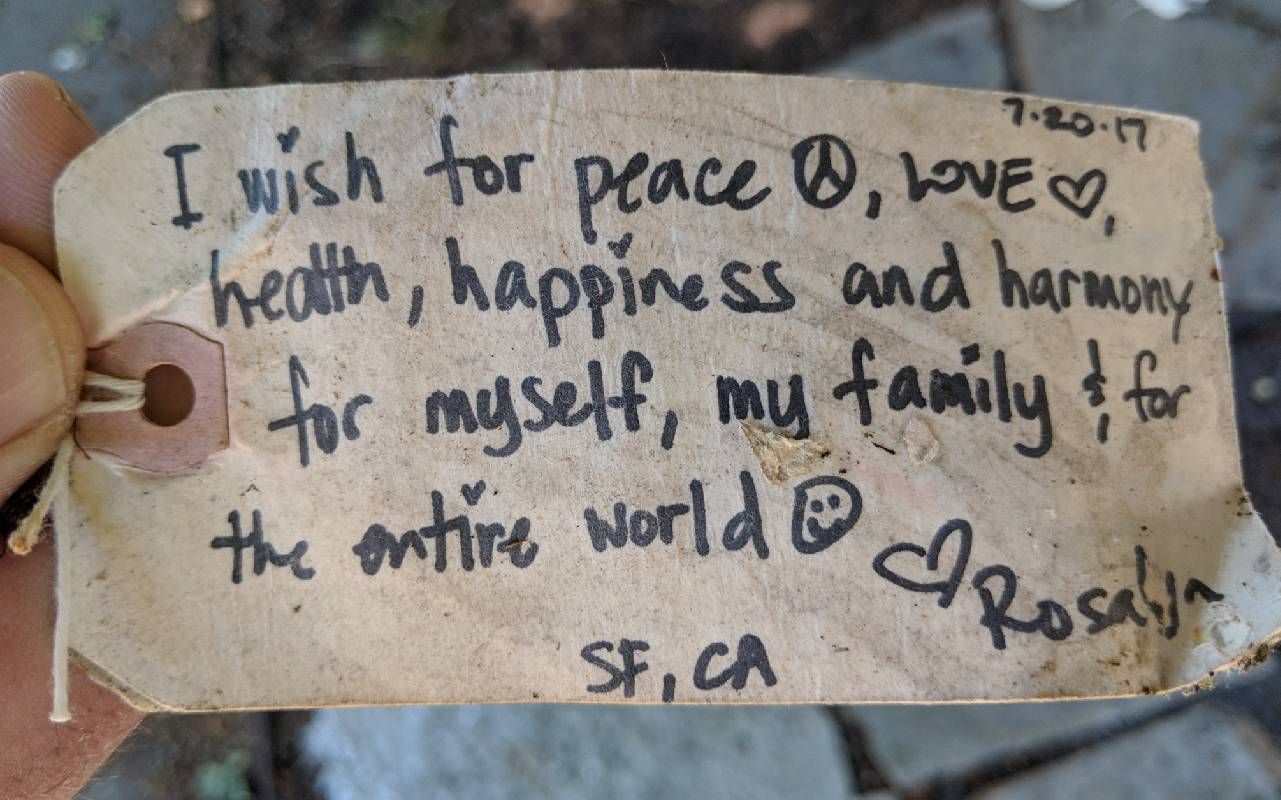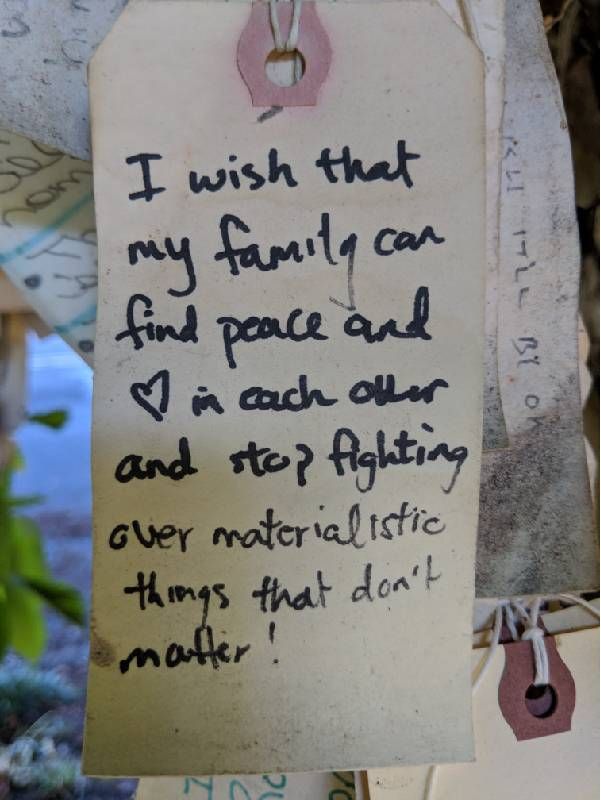The Magic of Wishing Trees
For those who've yet to encounter one, a Wishing Tree is just what it sounds like: a tree where one makes a wish

I am blessed.
About a mile from my home in Portland, Oregon sits an enchanting, somewhat renowned — and much beloved — Wishing Tree. Hundreds — thousands? — of hopes and yearnings are attached to its branches (with strings so as not to harm this mammoth chestnut tree).
For those who've yet to encounter one, a Wishing Tree is just what it sounds like: a tree where one makes a wish. Nowadays that usually means writing the wish down on paper and attaching it to the tree. Historically, these trees were a certain species — depending upon the culture — or were part of a religious shrine or destination. More about that in a bit.
The Wishing Tree near me is located in the parking strip in front of the house of Portlander Nicole Helprin. Helprin read a blog in 2012 penned by a woman who put a "wish tree" in her yard in San Francisco. Not long after, on a whim, Helprin wrote a few of her own wishes and hung them there on that stately chestnut tree in front of her house before a trip out of town.
When she returned, others had followed her lead, adding their hopes and dreams. Helprin made things official by providing instructions on a wooden clipboard (along with tags and Sharpie pens): "This is a Wishing Tree," the note reads. "Please find a blank tag. Write your wish — for you, a loved one, the neighborhood, the world … "
About a mile from my home in Portland, Oregon sits an enchanting, somewhat renowned — and much beloved — Wishing Tree.
Over the past decade, Helprin's Wishing Tree has, well, blossomed, lovingly supporting countless wishes among its branches. The sheer variety of the sentiments on display is striking, from the very personal ("I wish Grace feels better soon") to the more global ("I wish for world peace and an end to hunger and homelessness") to the hilarious ("I wish for one billion dollars" on one side of the tag and then on the flip-side "Or avocados.")
The Wishing Tree Experience includes both reading others' wishes — and creating your own, if you're so inclined. And then, perhaps, taking a moment to visualize all of this good stuff actually happening. Even the avocados.
My visits are — no other way to put it — therapeutic. I always come away from my mini-pilgrimages calmer, happier and more hopeful, having been reminded that there is a world filled with people thinking these loving, profound — and sometimes comical — thoughts.
Wishing Trees are, in my mind, holy places.
The History of Wishing Trees
Indeed, Wishing Trees — in one form or another — have been sacred destinations for millennia. Take clootie trees. Thousands of years ago, ancient Celts made pilgrimages to wells and springs believed to hold healing properties (another millennia-old theory). Those travelers dipped pieces of cloth (clooties in the old Scots language) in the water and then tied them to a nearby tree, hoping for good health.
Coin trees have been popular for hundreds of years, primarily in the British Isles. Visitors to these destinations (hoping, again, for good health; folks were pretty focused on just getting through another year back then) hammered coins, as spiritual offerings essentially, into trees. The coin-hammering became so popular that the National Trust for Scotland issued a warning in 2019, urging visitors to stop the practice which was harming some of the country's heritage trees.

Meanwhile on the other side of the globe, practitioners of Hinduism, Jainism and Buddhism have honored their own Wishing Tree, the Kalpavriksha, for millennia. Folks in Japan celebrate Tanabata, based on Qixi, the ancient Chinese legend about two star-crossed lovers. During the Edo period (1603–1868) the Tanabata tradition of writing wishes on small strips of paper (tanzaku) and hanging them from branches of bamboo trees began.
That brings us to the 2008 Group of Eight summit which took place in Japan and coincided with Tanabata. Japanese Prime Minister Fukuda asked G8 leaders to take part in the tanzaku ritual.
The world's leaders wrote their wishes on paper and hung them on a bamboo tree.
And they did. The world's leaders wrote their wishes on paper and hung them on a bamboo tree. George W. Bush hoped for "a world free from tyranny." Gordon Brown wished for "the eradication of poverty and an end to terrorism." Prime Minister Fukuda's wish was timeless: "learning from past wisdoms and creating new ones."
There's something going on here — something primal and universal and holy. There's nearly an equation to be had: humans + trees + longings = Sacred Wishing Trees. These modern-day iterations are shrines — just like their ancient counterparts — and we are the pilgrims, schlepping a mile — or a thousand — to visit, to hope, to wish, to dream.
My Five Reasons
If you're not yet convinced of the magical properties of these sanctuaries, here are my five personal reasons for falling in love with the Wishing Tree in my neighborhood.
#1: It makes me think.
This is surely the primary reason that I love my local Wishing Tree. Reading the wishes of others forces me to slow down and reflect on the world and my role in it.
My favorites are those that I need to dwell on a bit, that maybe I hadn't ever thought of but that, having now read them, I can see their truth: "I wish everyone the best, no matter what you've done in the past." "I wish to become the best me I can be and to inspire everyone to be the best thems they can be."
#2. It shifts my perspective.
Realizing that others' deepest hopes are often so basic ("I wish for my mom's health to get better," "I wish that the chemotherapy works") sheds a somewhat guilt-inducing light on my frequent kvetching. The yearning in some posts is sobering: "I wish to find my community. My tribe. My forever home."
My boring existence could be worse.

#3: It inspires creativity.
Along with humanity, there is art! For example: "I wish my cats could talk" (with not half-bad illustrations). "I wish unicorns were real" (again with illustrations). "I wish I wasn't a robot" (also with illustrations).
Some folks even bring their own home-made "tags" like the individual who hung a purple-dotted clam shell on the tree, emblazoned with "To Claim My Own Voice."
#4: It builds community.
You don't have to live in the neighborhood to feel a deep spiritual kinship during your Wishing Tree Experience. When you read about others' dreams and hopes — and add your own — and understand that we all share so many of the same goals, aspirations and thoughts, it's a powerful thing. Spiritual connection and community — not a bad place to start, whether we want to change the world or just get a second interview for a job.
#5: It gives me permission to dream.
How often do you ask yourself what you really want in this life? Not what others want for you or what the world tells you that you should want. Digging down deep into your soul for these hungers — and then declaring them to the world — is liberating.
There are many, many Wishing Trees around the country, from Boston to Seattle, from San Ramon, California to Norfolk, Virginia.
Can't find a Wishing Tree near you? Consider doing what Nicole Helprin did in Portland. Read this blog, follow the simple instructions. Now leave town for a weekend.
And return to magic.


